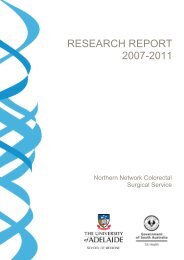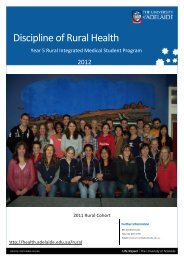Honours Project Book - Faculty of Health Sciences - University of ...
Honours Project Book - Faculty of Health Sciences - University of ...
Honours Project Book - Faculty of Health Sciences - University of ...
Create successful ePaper yourself
Turn your PDF publications into a flip-book with our unique Google optimized e-Paper software.
Respiratory and Sleep Medicine<br />
Supervisor/Contact Person<br />
Dr David Parsons<br />
Phone: 8161 7004<br />
david.parsons@adelaide.edu.au<br />
Our group is developing an effective treatment and potentially a life-long correction for the airway disease <strong>of</strong> Cystic<br />
Fibrosis (CF). This lung disease is the primary cause <strong>of</strong> worsening health problems in young people with CF, greatly<br />
affecting their quality <strong>of</strong> life and is the overwhelming cause <strong>of</strong> early death. We have been supported by grants from<br />
the NH&MRC, the USA CF Foundation, CF Australia and South Australian research funding bodies where we use a<br />
lentivirus-based gene delivery vector to study how to produce safe and effective gene delivery into airway cells.<br />
We use reporter genes such as LacZ and luciferase, to prepare for studies with the therapeutic gene CFTR.<br />
Our work has been focussed across three animal models: mice, sheep and marmosets. Our approach especially<br />
targets airway stem cells in vivo, and in some mouse studies this approach has already produced up to lifetime gene<br />
expression after a single dose event. The field has lacked a simple way to measure the success in airways and lungs,<br />
whether for humans or animal models. To overcome that limitation we have developmed new synchrotron X-ray<br />
imaging techniques with Monash <strong>University</strong> colleagues. Synchrotron Xrays allow non-invasive viewing <strong>of</strong> airway<br />
surfaces in live mice, at resolutions close to that <strong>of</strong> normal light microscopes. We are also now able to examine<br />
mouse lung airflows in 3-D. With further development we expect these techniques will create new options for rapid<br />
and accurate assessment <strong>of</strong> potential therapies (such as gene-correction) for their effectiveness in improving airway<br />
health in live and intact animal models.<br />
Our research is closely connected with the clinical needs <strong>of</strong> CF children, and most <strong>of</strong> our studies are carried out at<br />
the Women’s & Children’s hospital campus in Adelaide. The synchrotron X-ray studies are performed in Japan, and<br />
in 2010 parallel studies began with the assistance <strong>of</strong> Monash <strong>University</strong> collaborators at the new Australian<br />
Synchrotron in Melbourne. Finally, we have new state-<strong>of</strong>-the-art research laboratories in 2012! Through the<br />
enthusiastic initial work <strong>of</strong> the Cure4CF Foundation Ltd (www.cure4cf.org), and substantial completion funding<br />
provided by the WCH Foundation, the Alan Scott CF research laboratory is now in place in the Gilbert Building at the<br />
WCH<br />
PROJECT (Basic): Airway gene transfer for cystic<br />
fibrosis: converting fluid-based lentiviral gene vector<br />
delivery to aerosol delivery.<br />
.R.<br />
This study is designed to translate our well established<br />
and effective protocols for bolus-delivery <strong>of</strong> the<br />
lentivirus vector in airway into one that can be<br />
provided in an aerosol form. Aerosols are considered<br />
to be the most practical way to deliver lung gene<br />
therapies in the future.<br />
Preliminary data from our group indicates that the<br />
viability <strong>of</strong> the vector can be largely preserved with<br />
the incorporation <strong>of</strong> specific supporting protein<br />
agents in the viral vector carrier fluid. Using a<br />
clinically-applicable electronic aerosolisation device<br />
(Aerogen) the study will be designed to define the<br />
parameters <strong>of</strong> vector delivery to maintain viability for<br />
in-vitro assessment.<br />
Once those parameters have been defined aerosol<br />
delivery will be tested in the nasal and lung airways<br />
<strong>of</strong> laboratory mice. The outcome sought in this<br />
<strong>Honours</strong> year is to define an effective aerosol-based<br />
delivery using in-vitro methods and apply it in-vivo to<br />
laboratory mouse airways.<br />
PROJECT (Basic): Enhancing airway gene transfer for<br />
cystic fibrosis treatment: effects <strong>of</strong> agents repurposed<br />
from current use in clinical care.<br />
.R.<br />
Agents used clinically to clear CF airways <strong>of</strong> mucus<br />
and cellular debris may be helpful in improving initial<br />
gene transfer into airway surface epithelial cells, by<br />
enabling better access by the gene vector to the<br />
defective epithelial cells lining the affected airways.<br />
Initial studies will utilise airway-specific cell cultures to<br />
screen a range <strong>of</strong> these potentially useful<br />
compounds, with lead candidates moving to<br />
preliminary testing using our established gene transfer<br />
methods in the airways <strong>of</strong> laboratory mice.<br />
The outcome desired is to achieve more efficient<br />
levels <strong>of</strong> airway gene expression with reporter-genes,<br />
to improve the future opportunities for development<br />
<strong>of</strong> therapeutically active and effective airway gene<br />
expression using the corrective CFTR gene.<br />
70 |





